News
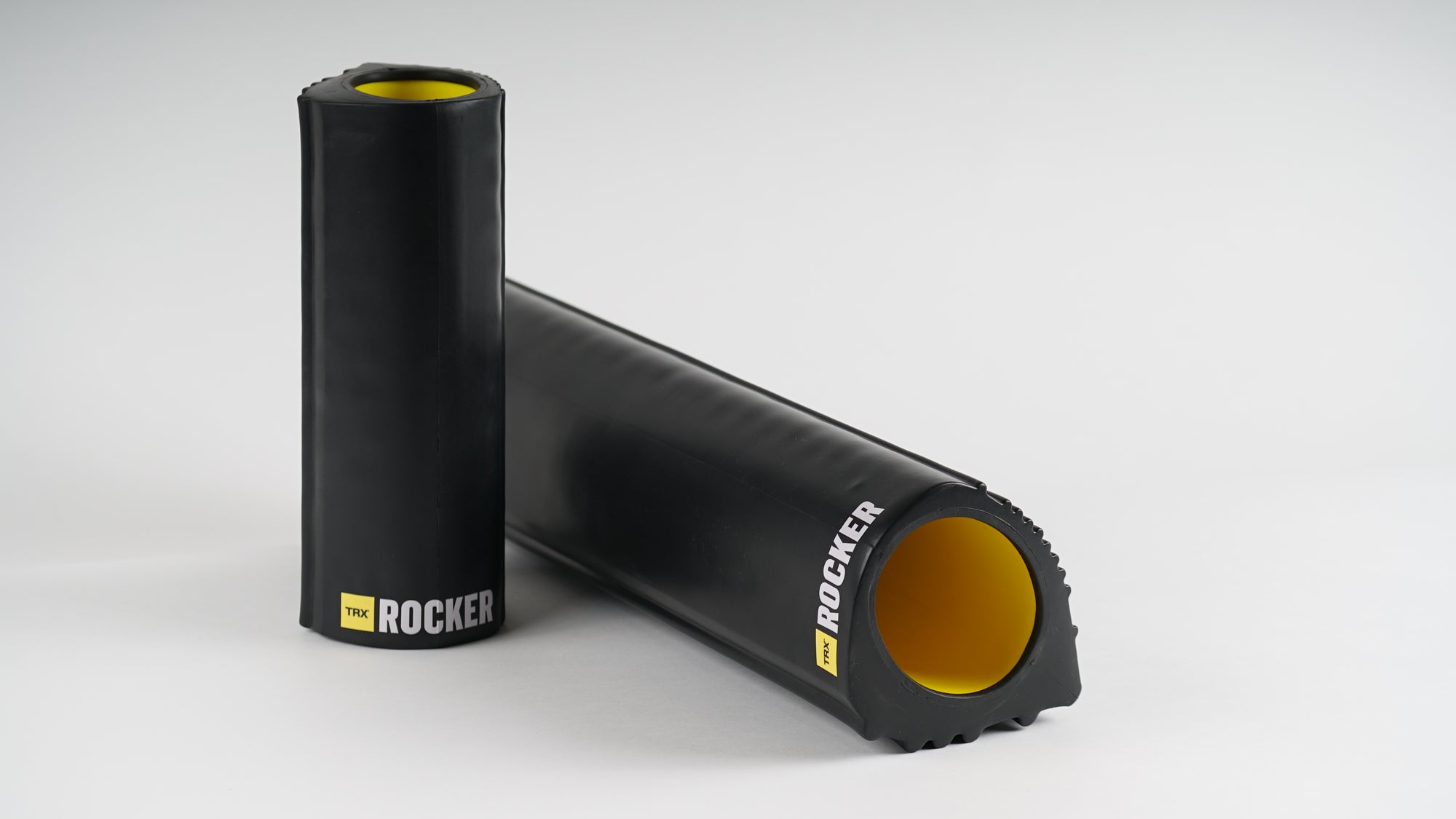
More Rock, Less Roll: Why You Need the TRX Rocker
Approximately 18 hours after a tough workout, it hits you: delayed onset muscle soreness, also known as DOMS. It’s the feeling you get when you wake up, but you can’t sit up in bed because your abs are aching from a core workout; the regret that sets in when sitting down and standing up seem like unreasonable measures because your butt hurts too much from deadlifts.
DOMS is a symptom of microscopic tears in your muscles. (It sounds like something out of a horror film, but it’s actually a good thing.) That pain means your muscle is growing after a workout. Despite that silver lining, pain isn’t fun, and there is a way to minimize DOMS: myofascial release.
Most people turn to massage or foam rolling for myofascial release, and—let’s be honest—neither a sports therapy massage nor a marathon session with the foam roller are particularly fun. The reason either solution works is it requires applying and releasing pressure to tight areas of tissue. The drawbacks? Massage is expensive, and it’s easy to skip out on foam rolling when things get uncomfortable. The TRX Rocker provides a better, affordable alternative. Let’s talk about why.
Standard foam rollers come in a uniform density or pattern: you either get a smooth cylinder, or a bumpy style, depending on what you’re in the market for. The TRX Rocker, by contrast, has three contact points: a low intensity, lightly-grooved side for more gentle massage, a medium intensity, more deeply-grooved side for deeper release, and the apex of the two sides, for high-intensity target areas. Instead of purchasing three foam roller styles, you can get everything in a single tool with the Rocker.
Even better, the Rocker’s unique, tear-drop shape is more intuitive for myofascial release. Imagine placing a standard foam roller on its long side, and kicking it: it would continue rolling away until it lost momentum. A foam roller wants to do the same thing when you’re using it. You’ve probably noticed that your shoulders have to work a lot while you’re foam rolling to move your body across the roller. The Rocker shape is designed to rock back and forth, so using it is less draining on your upper body.
With a new year comes renewed commitment to exercise and wellness. Each January, people dive into a workout routine, and spend days on the flip side hobbling around town with DOMS. It’s time to break the cycle. Instead of looking at your fitness goals as a way to punish yourself for bad choices of the past, embrace the opportunity to treat your body better in the New Year. Whether you drop into a Spin class, take your dog for a run, or spend hours on your TRX Suspension Trainer, be sure to treat your body right. This is the time for you to get on a roll with your TRX Rocker; are you ready to accept the challenge?
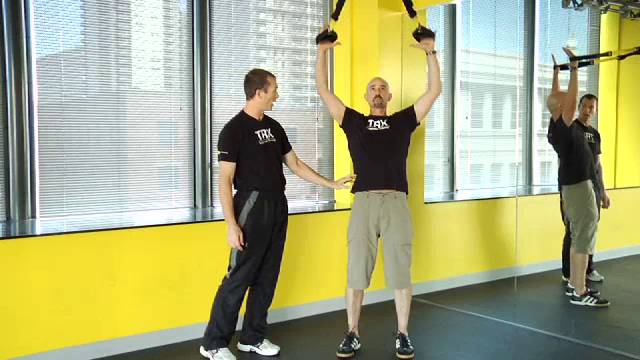
Mobility vs Flexibility With TRX
Get the most out of your TRX workouts by incorporating an understanding of flexibility and mobility, and how it relates to building your total body fitness. In the wide world of fitness talk, flexibility and mobility are two terms that are often thrown around interchangeably, uttered in the same breath, assumed to mean the same thing. However, this is not really the case, certainly not at TRX. Let’s break this down a little.
When we refer to flexibility, we are talking about the total available range of motion. In the video above, you can see the shoulder flexibility of TRX Director of Programming, Noah Rolland, expressed by his ability to lift and lower his arm. This does not necessarily express how well one can use that range of motion; that is where mobility comes into play.
Mobility is how well you can move through a range of motion. In essence, mobility capitalizes on your flexibility. Being able to use your full range of motion while performing a strength building exercise first requires flexibility, and then mobility is used to move the load through your full range of motion utilizing strength.
It may sound trivial, but an understanding flexibility and mobility as two separate but interdependent elements is crucial to your fitness. It may sound trivial, but an understanding flexibility and mobility as two separate but interdependent elements is crucial to your fitness. Want to discover exercises that match your current flexibility and mobility levels? Take our quick assessment to get personalized recommendations that work for your body.
TAKE OUR TRAINING QUIZ
For example, how often while training do we see our strength limited by poor mobility (being able move through a full range of motion) because we have poor flexibility?
Watch as Noah along with TRX Director of Sports Medicine Brian Bettendorf show you how you can modify a strength exercise, the TRX Split Fly, into a mobility drill by changing Noah’s angle relative to the anchor point and modifying his foot position, thus unloading the movement. This provides a good example of how flexibility, mobility and strength are all related yet separate entities requiring individual focus.
Do you use the TRX Suspension Trainer for mobility drills before you perform a strength workout? Maybe you should start.
If you want more mobility and flexibility workouts, check out our TRX for mobility and flexibility training page.
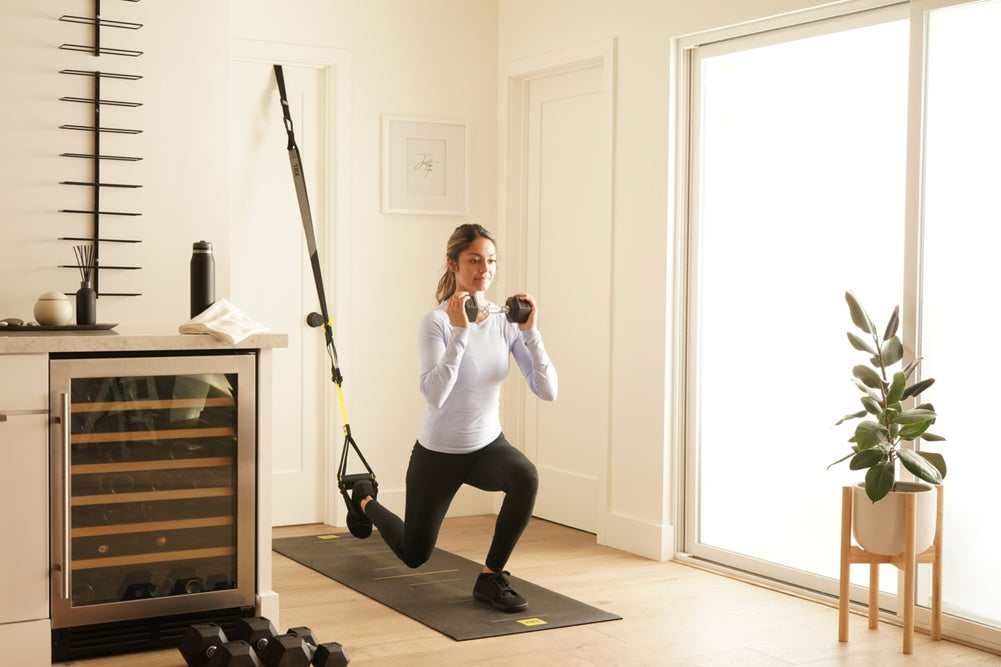
Mixing Suspension Training with Kettlebells
Discover a powerful workout combination with suspension training and kettlebells by TRX. Learn the benefits and tips for incorporating them into your routine.

MILITARY INSPIRED TRX COMBAT-READY WORKOUT
For most of us, training is a means to staying healthy, mobile, confident (ie. looking great for swimsuit season), etc... All valid motivators. But for our men and women in uniform, the fight to stay fit is a paramount component to protecting our lives and freedoms - perhaps a slightly more daunting goal than simply “looking and feeling good.”
TRX’s ties with the military run deep. Not only was the TRX Suspension Trainer conceived in the military, but TRX products, education and programming have become ubiquitous tactical PT staples. Something we are extremely proud of.
TRX Master Instructor, Brandon Wagoner, is a large part of this feat as he has been leading TRX Education Courses for active duty personnel for nearly a decade. His work with the military has been profound, or as he puts it, “one of the most rewarding experiences of my professional career.”
Wagoner adds, “While I enjoy leading all TRX Courses - to both civilians and active duty personnel - there’s something unique about [working with the military] in that it gives me a sense of obligation that’s hard to put into words. In many cases, the individuals that are taking these courses are putting their lives at stake to protect our everyday freedoms. Needless to say, I take the job of helping them stay in peak condition very seriously. When I step onto that teaching platform, I’m highly cognizant of the fact that the lessons I’m sharing with them could contribute to saving the life or lives of others. I realize my part in that process is relatively small, yet it feels significant.”
In honor of our servicemen and women this Veterans Day, Wagoner has created this military inspired "combat-ready" workout. Want to train with military-style intensity? Take our quick assessment quiz to get a personalized tactical training plan. These exercises are designed to build the strength, durability, endurance and agility needed for military readiness.
TAKE OUR TRAINING QUIZ
TRX "COMBAT-READY" WORKOUT
How it works: Do 8-10 reps of each exercise. Repeat the entire series 2-4 times.Total Time: Up to 30 minutesYou will need: TRX Suspension Trainer
1. TRX INVERTED ROWS This exercise is excellent for developing integrated core, upper and lower back strength.
Squeeze your shoulder blades together and use your lats to pull your body up until your hands are at the side of your rib cage. Slowly lower your body back down to the start position.
2. TRX SPIDERMAN PUSH-UPSThis exercise mimics crawling patterns as well and developing total-body strength.
Put your toes in the foot cradles. Lift the hips so you are in push up position. Perform a push-up. At the end of the push-up movement, lift hips up and pull both knees to the elbows.
3. TRX SQUAT JUMP Increase leg strength as well as improving explosive power and deceleration of load.
Stack elbows under shoulders, feet hip width apart. Lower hips down and back, weight in heels. Drive through heels, squeeze glutes, lift chest.
4. TRX POWER-PULL Total body exercise that increases strength in pull mechanics and helps develop rotation and unilateral strength.
Slowly lower your body away from the anchor point with your working hand, letting yourself rotate away, until your non-working hand is reaching toward the ground. Maintain your plank. Pull yourself back to the start position in one controlled movement until your non-working hand is touching the suspension trainer. Repeat on both sides.
5. TRX BURPEEIncrease single leg strength, power, explosiveness and stability in all planes. Simulates going from the crawl to standing and potentially to a run.
Adjust the TRX Suspension Trainer so that the bottom of the foot cradles are at the middle of your calf. Stand facing away from the TRX and place one foot in both cradles. Lunge down and lower your hips while driving your suspended leg back, until back knee is two inches from ground. Place your hands on the ground and hop your grounded leg straight back to a plank position. Perform a push-up then hop your grounded leg forward and explode up to a jump.
6. TRX OVERHEAD SQUATEngages more than 200 muscles in the entire body, enhances strength in the posterior chain, improves squat mechanics, mobility in shoulders and hips, and stability in the core.
Stand facing the TRX with your hands extended over your head in the foot cradles, pulling back so that there is tension on the straps. With your feet shoulder-width apart and your hands still overhead, squat down until your thighs are parallel with the ground.
If you want a complete tactical conditioning program, download the new TRX FORCE Super App here.
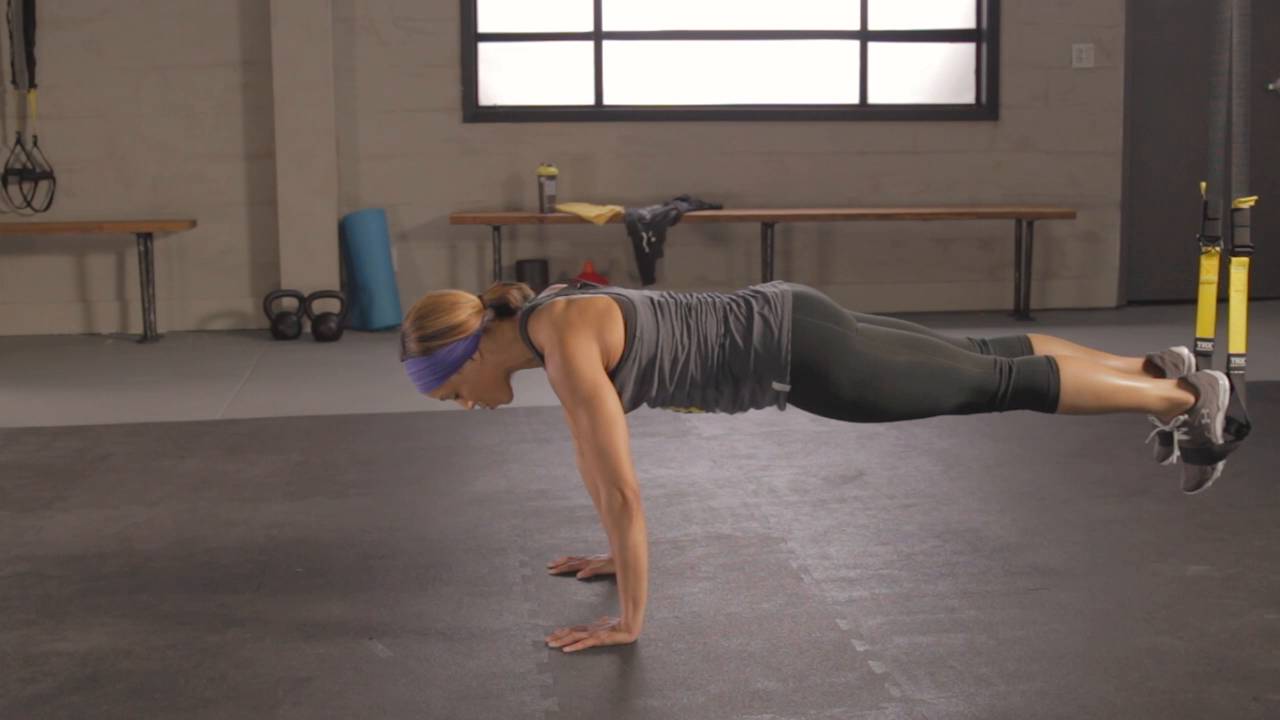
Metabolic Burn Workout: 15-Minute Fitness with Basheerah Ahmad and TRX
If you want an awesome workout to ignite your metabolism and burn a ton of calories, fast, try this quick and effective 15-minute, total-body blast from celebrity trainer Basheerah Ahmad and TRX. Designed to help you get an incredible results in the time you have, this workout will get your heartrate up and your waistline down. No matter what your fitness level, there is a modification for each of these five exercises that anyone can perform.
Perform each exercise for 60 seconds, resting for 30 seconds between each exercise. After you finish the full sequence, start at the top and work your way back through only this time use the opposite leg.
TRX Push UpStart in a plank position with your toes in the foot cradles of the TRX Suspension Trainer and your hands under your shoulders. Use your arms to lower yourself down in one controlled motion until your chest is just above the ground. Brace your core and drive your body up, maintaining a plank position to return to the start.
TRX PikeGet in a pushup position with your feet in the foot cradles of the Suspension Trainer, directly under the anchor point. Brace your core and pike your hips up while letting your head drop between your arms, and moving your feet toward your upper body. Drop your hips back down under control, and return to a plank position
TRX Atomic Push UpsStart in a pushup position with your feet in the foot cradles of the Suspension Trainer, directly under the anchor point, and your hands under your shoulders. Brace your core and perform a pushup. When you reach the top of the push up, pause for a moment and perform a TRX crunch by drawing your knees toward your chest and pikeing your hips up slightly. Pause for a moment at the top, then lower your hips back down and straighten your legs to return to the start position.
TRX Suspended LungesStart standing on one leg facing away from the anchor point with one foot suspended in both foot cradles. Brace your core and focus on standing up straight as though you are performing a single-leg plank while standing up. Drop your hips down and back into a deep lunge. Keep the shin of your working leg vertical and your chest up. Stop at the bottom when working knee is at 90 degrees. Drive through your front leg to return to the top of your lunge. Engage your core and keep your chest and head up throughout the entire movement.
TRX Squat JumpsAdjust the TRX Suspension Trainer to mid length. Stand facing the TRX with your feet hip width apart. Position your elbows under your shoulders and lower your hips down and back, keeping your weight in your heels. Squeeze your glutes and drive your hips up to explode and jump at the top of your squat. Use the TRX straps to help you decelerate and land as softly as possible. Keep your chest lifted throughout the movement.
If you want more fat-burning, muscle-toning workouts from Basheerah and TRX be sure to watch the rest of the 15-Minute Fitness Workout series, here.

Matt Dixon Run Drill #6: Side-To-Sides
In this video, Triathlon Coach Matt Dixon of Purplepatch Fitness explains how to perform two lateral movements. First up is Crossovers. Start by standing upright with shoulders and hips facing forward. Cross your back leg behind the lead leg, swinging your arms opposite to that leg, and then step to the side with the lead leg, again swinging your arms in the opposite direction. Continue for 15 seconds and then stop and move in the opposite direction.
For the side to side movement, start by standing upright with shoulders and hips facing forward, feet shoulder-width apart. Step out with the lead leg and then push with the following leg to bring the feet back to the start position. Continue this rhythmic action, combined with swinging arms, for 15 seconds and then stop and move in the opposite direction.
Next up in the series, we'll cover our final drill, Strides.
For more on Matt Dixon, visit purplepatch fitness (purplepatchfitness.com) or check him out in Outside magazine. TRX has partnered with Dixon to offer you a variety of interactive training plans available on TrainingPeaks.com. For a FREE demo, click here.
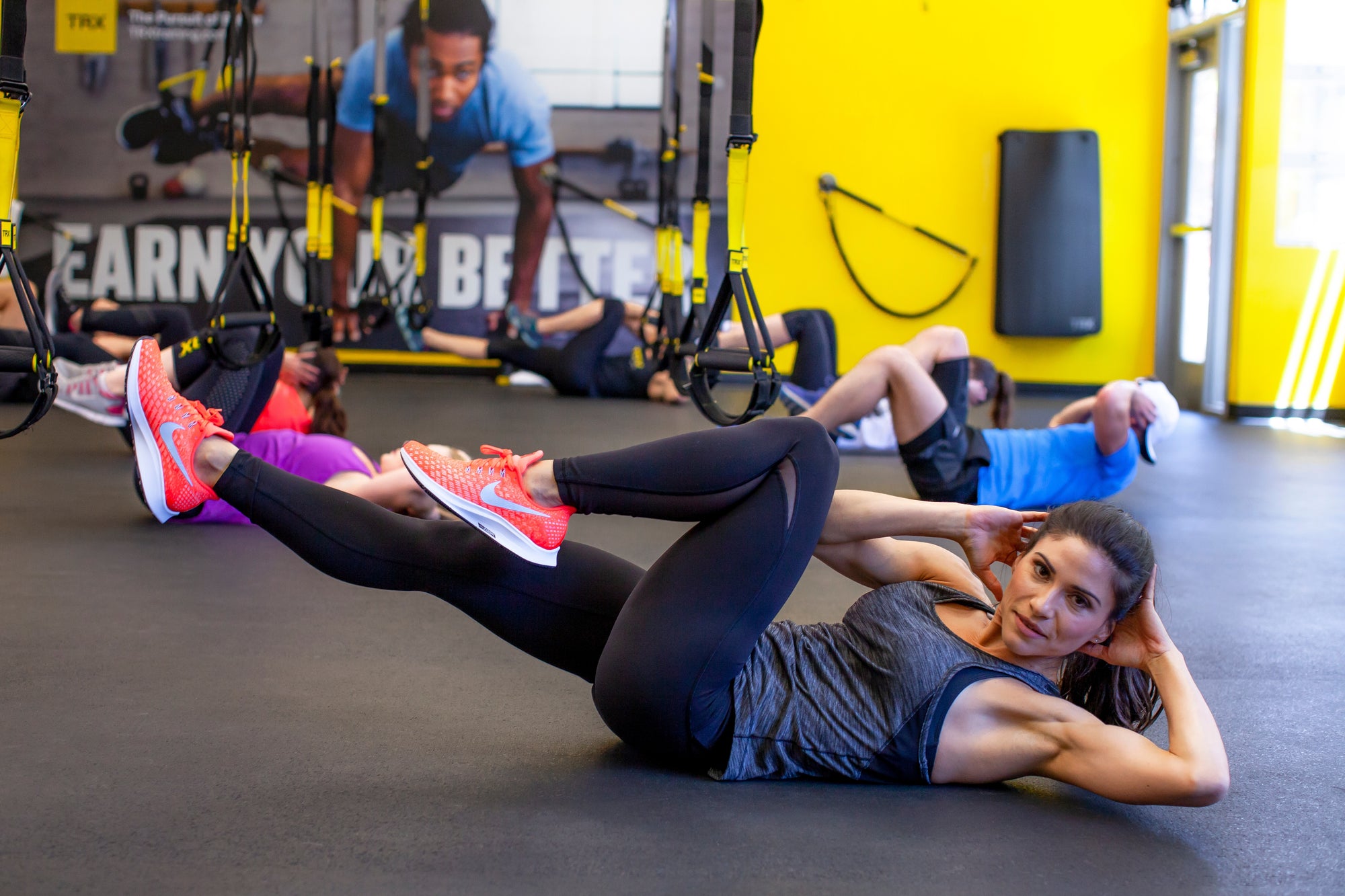
Made2Move: A Texas Trainer Shares Her Wellness Routine
Priscilla Barrera-Cintron has been active her whole life. She started with gymnastics, jazz, and ballet at age 2, and never slowed down.
The Laredo, Texas-based nutritionist and trainer knew as a teenager that she was destined for a career in wellness. She became a registered dietician after college, started competing in fitness competitions in 2007, and opened her gym, Origin Method, earlier this year. “It’s always been a passion of mine to take it to that next level: looking good, feeling good, having sustained energy and staying healthy,” she said. “Movement is not just my passion; it’s my sanity, it’s my happiness.”
Origin Method is Barrera-Cintron’s way of helping other people find that same passion and happiness in movement. “It’s a dream I’ve had since I was 17 years old: to help transform other people’s health and bodies. Origin Method is just the beginning of learning the lifestyle. It’s personalized nutrition and fitness training for families and individuals that provides a challenge and delivers effective results,” she said.
For Barrera-Cintron, the most rewarding aspect of creating Origin Method is helping her clients make sustainable changes that achieve results. People appreciate that her nutrition programs don’t feel like “diets,” and her workouts can be adapted to any fitness level.
TRX has been a major part of Barrera-Cintron’s wellness journey, both as a fitness competitor and a wellness entrepreneur. She learned about the TRX Suspension Trainer years ago through another coach, and she knew that it was a tool she wanted to use when she opened her own studio. “It doesn’t matter if I have 6-year-old kids or 70-year-old adults; it’s a tool that allows me as an owner, trainer, and coach to take my clients from easy workouts to challenging workouts.” She also uses the Suspension Trainer in her own workouts, whether that’s TRX for yoga—“I’m a beginner and it’s so challenging,” she admits—or traditional strength training.
As part of her own routine, Barrera-Cintron sets aside time every day for self-care, dedicating 20 to 40 minutes each morning or evening for exercise and 20 minutes for daily meditation. “I love integrating different moves with the TRX Suspension Trainer, box jumps, sprints, agility, drills, plyometrics, cardio, strength and core. I usually aim for 250 minutes a week.” On top of her personal fitness schedule, she teaches 8-10 fitness classes each week at Origin Method, and spends time running and playing with her daughter.
Establishing and maintaining healthy lifestyle doesn’t have to consume every minute of your day. No time to travel to the gym? Take a short run or squeeze in exercises with your TRX Suspension Trainer. Remember that movement can take on many different forms beyond squats and burpees; it could even be as simple as taking your dog for long walks, or riding your bike to the farmer’s market. Trying to spend more quality time with your kids? Bounce with them on a trampoline or play tag in the park.
While her 9-to-5 gig may center around wellness, Priscilla Barrera-Cintron is a great example of how committing to a few small efforts can make a big difference. Allotting even 20 minutes each day for movement can help improve health, relieve stress, and make you feel happier.

Mastectomy Recovery - Post Operative Breast Cancer TRX Exercises
Post Operative Breast Cancer TRX Exercises
The more I learn, the less I know. I’ve been a fitness and nutrition professional for 11 years now but it is moments like these where I set out to understand something that is outside my experience that I am most humbled. October is Breast Cancer Awareness Month and when the opportunity to write a blog for my TRX peers and community presented itself I felt compelled to take action. I had no idea what I was about to learn about the complexities of breast cancer but when I sat down with a colleague of mine and Breast Cancer Exercise Specialist Vicki McGrath, I was both humbled and enlightened. Let me be clear and state that this blog is not intended to educate or inform you of the differences between a Lumpectomy, Mastectomy, Sentinel Node Surgery, Lat Flap, or Lymphedema. Living with breast cancer and recovering from invasive procedures is a major life challenge but we, informed fitness professionals, are in a position to become well enough equipped by opening our minds and hearts and expanding our skill sets for a population that can certainly benefit from the passion, care, sensitivity, and knowledge we posses. More significantly, we are ideally positioned to share exactly how wonderful the TRX Suspension Trainer is as a tool for those recovering from breast cancer surgery, radiation, chemotherapy, and reconstruction.
There are 10 types of breast cancer! All women with breast cancer come into our experience with very unique stories. What I can share is that how we approach working with each individual is highly dependent on the type of breast cancer they have, the type of surgery and/or reconstruction performed, as well as whether radiation and chemotherapy are part of their treatment. Also, women come to us at different fitness levels paired with varying levels of recovery and so we must consider so many different variables at once that it can seem quite overwhelming.
The most important thing to remember is that for breast cancer patients who are dealing with treatments and therapies that are out of their control, exercise is the one thing they can control. While everyone's journey is unique, our fitness assessment quiz can help identify safe and appropriate exercises tailored to different stages of treatment and recovery. You are there to help them gain a sense of control back in their life.
TAKE OUR TRAINING QUIZ
What common ground do most breast cancer patients share? How can we as fitness professionals serve them? How can we use Suspension Training to give them back the level of fitness they once had? It is safe to say that regardless of the type of breast cancer the one thing most of these women share is a high degree of internal rotation in the musculature of the upper back and shoulders. Breast cup size, women who had office jobs prior to surgery, and the fact that surgery makes our posture even more “protective” all contribute to this pattern of internal rotation. The Suspension Trainer is a wonderful tool to help cultivate external rotation, stability, and strength in the postural muscles of the upper back and shoulders. It goes without saying that the Suspension Trainer is the best piece of pulling gear on the market and so working on Low Rows and Mid Rows are relatively great choices across the board because they are easily regressed and progressed.
Next, what I concluded after speaking with expert Vicki McGrath who manages a post operative breast cancer exercise program - The Pink Ribbon Program, at the Peninsula Jewish Community Center in Foster City, CA, is that range of motion and strength are the primary goals of all breast cancer patients. Vicki states: "I see women who were particularly athletic pre-surgery want to do push-ups as soon as possible BUT the TRX Chest Press should NOT be among the first exercise choices". I am going to suggest that in addition to range of motion, stability and strength, losing weight will be a primary goal as well because chemotherapy, stress, and inactivity all contribute to weight gain. I imagine a woman who has gone through breast cancer wants to feel strong, fit and full of energy and suspension training is a wonderful way to do this while having fun!
Let’s leave the TRX Jump Split Squats, Atomic Pushups, Y Deltoid Flys, Single Leg Burpees, Rollouts, and a multitude of other exercise choices you may imagine on the back burner for now and focus on a few exercises that are really going to help increase both range of motion and strength.
TRX Modified Superman
The TRX Modified Superman is a great choice to increase range of motion. We are going to fully lengthen the straps if for no other reason than to provide the experience of freedom and personal power. Yes, this may go against the length convention we as TRX professionals are familiar with but Vicki has worked with many breast cancer survivors and they simply like how having the straps fully lengthened feels. Stand facing away from the anchor point and assume a slight hip hinge with heels lifted to engage the legs just enough without overemphasizing the squat since we are focusing on shoulder mobility. Raise your arms overhead and alternate bringing one hand down to the shoulder as the arm flexes. Extend the arm back to the starting position and switch arms. You can also move both arms in unison. It is perfectly appropriate to add the squat back in once the client feels grounded and stable in the torso, especially since combo moves that include the larger muscles like quads, hams, and glutes are going to facilitate weight loss as well as overall strength.
TRX Single Arm Golf Swing
Another wonderful exercise is the TRX Single-Arm Golf Swing. We are going to fully lengthen the straps again and stand facing the anchor point with the arms extended at about waist height. With knees soft and a slight hip hinge, begin rotating from the thoracic spine as you raise one arm up and back. Given the nature of breast cancer surgery and the amount of scar tissue and potential tension in the scalenes, it might be a good idea to turn the head and follow the hand of the moving arm as opposed to keeping the gaze on the imaginary golf ball.
TRX “Staying Alive”
One of Vicki McGrath’s favorite exercises and stretches goes by the name of “Staying Alive” because the posture and stance look like John Travolta! Stand facing away from the anchor point with your right hand on your right hip. Offset your stance with the left leg forward and then reach your left arm up. You can increase or decrease both the intensity of the stretch and range of motion by simply leaning forward onto the left leg and then backing off. The ultimate goal is to work the entire range of motion from the arm being overhead to 90 degrees or out at the side of the body. This is accomplished best by incrementally adjusting the arm position as you explore and cultivate your range of motion.
They say the first step towards Enlightenment is Awareness. After spending time with Vicki McGrath and learning about the many types of breast cancer and overall invasive nature of its many therapies, I can confidently say my awareness to its complex nature has grown exponentially. Further, I have an entirely new level of respect for those who are impacted by breast cancer and have the strength and will and good fortune to survive breast cancer. It fulfills me to know that we fitness professionals can play a small yet significant role along the road of recovery. It fulfills me even more to know that we TRX coaches possess a unique skill set to help those who cross our paths to move better and train better. If we can help facilitate a smile as well along the way then all the better….
About the author: Kevin Defro
CERTIFICATIONS: NASM-CPT, C.H.E.K. Practitioner Level 1 & HLC 2, IKFF Kettlebell Coach, FDN, CMTA, TRX Senior Course Instructor, Training for Warriors, Levels 1 & 2, DVRT Master Trainer, TriggerPoint Performance Master Trainer, USAW1, Precision Nutrition 1
Kevin is a California native with an immense passion for life, holistic health, fitness, nutrition and music. He has spent over 10 years as a professional in the fitness and nutrition industry. His passion for fitness developed as a youth playing soccer, baseball, tennis, swimming, and running Cross Country. He began weight training at the age of 15 and was introduced to the world of organic food and nutrition in his college years. With a Bachelor’s Degree in Psychology from UC Berkeley, Kevin integrates his interest in helping people into all of his pursuits.
His roots are in corrective exercise, but Kevin has an extensive skill set which includes the use of Russian kettlebells, ultimate sandbags, joint mobility exercises, TRX Suspension Training, TRX RIP Training, Olympic lifting, battle ropes and bodyweight training. He is currently working with private clients on the Peninsula, teaching TRX Suspension Training and an exclusive training camp at Equinox Palo Alto, and coaching bootcamps in Menlo Park. He is also a fitness educator and represents several companies as a Master Trainer and educator.
Vicki McGrath, ACSM- EP-C, HFD, CET
Certified Cancer Exercise Trainer
Breast Cancer Exercise Specialist
TRX Suspension Training
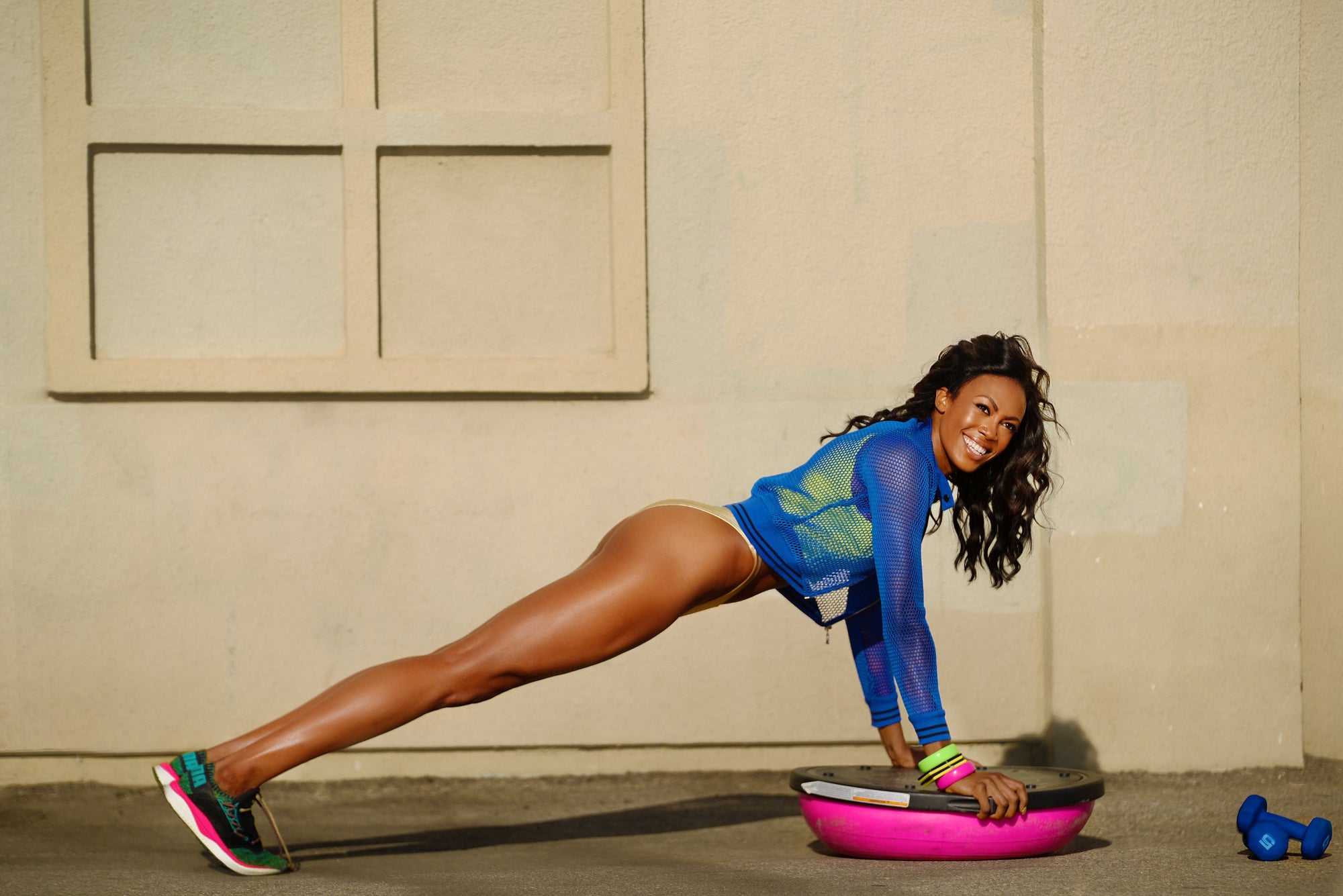
MADE2Move: How Olympic Medalist and Personal Trainer Kim Glass Stays Motivated
Kim Glass has worn a number of hats throughout her career. She’s been a volleyball player, a professional athlete, an Olympic medalist, a personal trainer, and a model. Along the way, the real test of Glass’s strength and grit didn’t come with the career highlights, but when she couldn’t stand or walk upright. For Kim, it took a performance-limiting condition to remind her she was Made2Move.
Kim grew up in a competitive family, and started playing basketball a young age before making the switch to volleyball in high school. High school competition paved the way to High Performance Camp, collegiate sports, and eventually a professional career overseas. In 2009, while playing in Russia, Glass started “getting weird sensations” in her back. In 2010, she learned that she had a herniated disc while she was playing in Czech Republic. But, as elite athletes tend to do, she kept playing.
While training with USA Volleyball back in California, Glass awoke one morning to discover the simple things she took for granted—like her ability to roll out of bed each morning—suddenly weren’t so simple. “I remember collapsing to the floor, as if an invisible foot kicked me behind my knees,” she said, “I felt a surge of pain that stream from my back into my toes. I tried to get up, and I couldn’t.”
Glass eventually crawled through her home to get ready for volleyball practice, and drove herself to the gym. Practice, however, wasn’t going to happen. Instead, she was sent to the doctor. The diagnoses: a herniated disc and sciatica.
Although she was a candidate for surgery, Glass opted for movement-based recovery instead, embracing Pilates. Her program worked so well, she was able to return to professional competition. Years later, she remains pain-free and a stickler for proper form.
“Being in a position where you can’t laugh hard, sneeze or cough, get yourself to rise out of the bed the way you’ve done over and over again throughout your life; not being able to bend over and put on your own socks, pants, or shoes: it puts everything in perspective,” she said. “You start to realize the integral role your spine plays in your life, and how much you take for granted.”
Now, as a trainer, Kim can use her own experiences to motivate clients to listen to their bodies and establish safe practices to avoid injuries.
“Movement—and efficient movement—is important to me, because I don’t want to experience that ever again, and I want to make sure others don’t have to as well. I want to value the vessel, and celebrate my body’s freedom to move, by getting out and moving every day.”
